
For this edition of Classic Steel, we are going to take a look back at Yamaha’s all-new YZ250 for 1986.
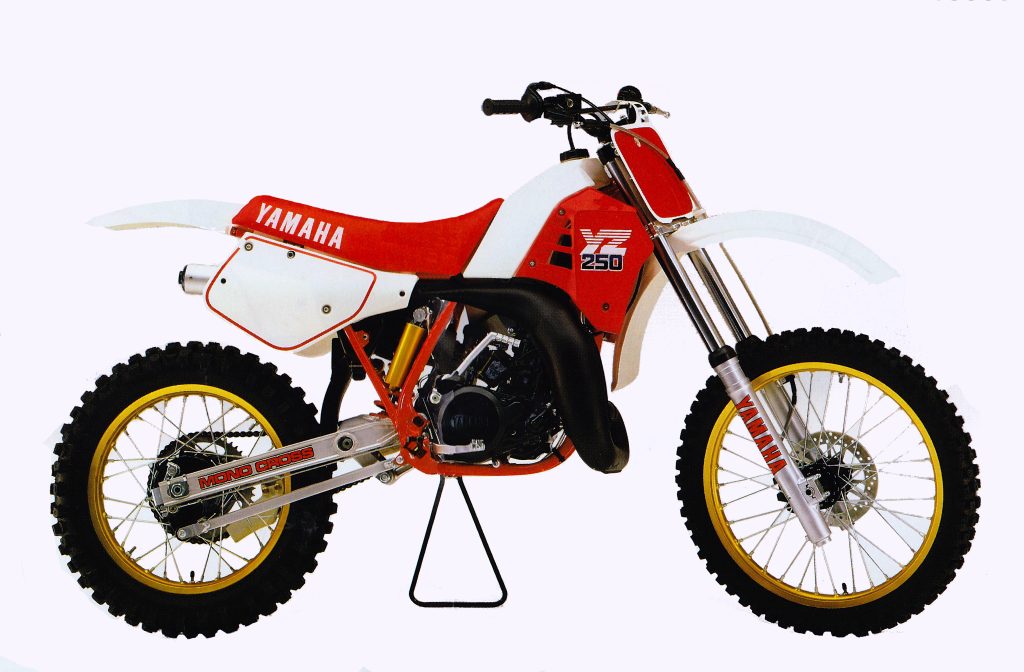 All-new for 1986, Yamaha’s YZ250 offered pro-oriented power and a much-improved handling package. Photo Credit: Yamaha
All-new for 1986, Yamaha’s YZ250 offered pro-oriented power and a much-improved handling package. Photo Credit: Yamaha
The mid-eighties were a bit of a mixed bag for Yamaha in the 250 class. While their motors were often the best in the class, the chassis performance of their deuce-and-a-half racers often left quite a bit to be desired. In stock condition, the YZ250 was often faster than the other brands modified machines, but its poor turning, grim suspension, and sub-par ergonomics dropped it down in the final standings against its rivals. In 1985, that had once again been the case as the YZ dominated the motor standings with an absolute rocket of an engine. The ’85 YZ barked at the slightest hint of throttle and pulled like a freight train through the middle. With its innovative Yamaha Power Valve System (YPVS) the YZ offered the most torque and widest powerband in the class. After that, however, the YZ package totally fell apart in 1985. Both the forks and shock were woefully undersprung and poorly damped and, according to Dirt Bike magazine, the chassis offered the handling precision of a “bus with low tire pressure.” It was a ripping fast motorcycle in need of a major chassis overhaul.
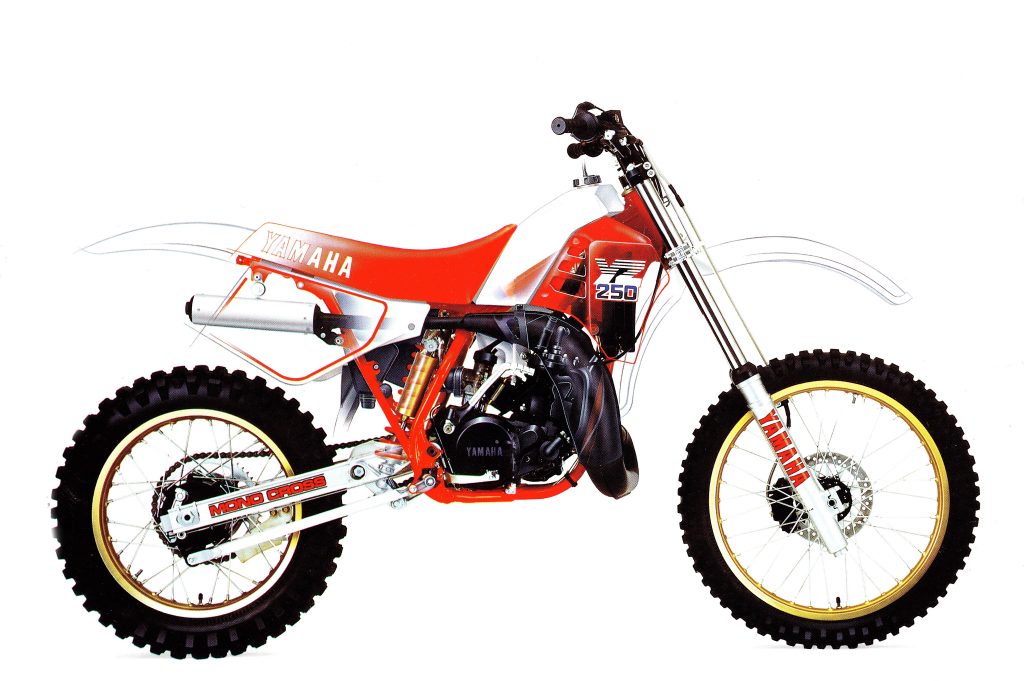 All-new bodywork for 1986 improved comfort, lowered the center of gravity, and aided rider movement. Photo Credit: Yamaha
All-new bodywork for 1986 improved comfort, lowered the center of gravity, and aided rider movement. Photo Credit: Yamaha
For 1986, Yamaha decided it was finally time to take a hard look at the chassis on the YZ250. The bike’s reputation for handling imprecision and inopportune (Yama) swaps was well known and a complete reimagining was the only way to bring the YZ up to snuff against its rivals. In order to accomplish this, Yamaha’s engineers dialed up an all-new frame and completely redesigned rear suspension system for the YZ. In 1982, Yamaha had finally retired their original monoshock rear suspension system in favor of a new linkage-equipped design that was a hybrid of old and new. The new Mono Cross system maintained the highly placed and laid-down shock arrangement of the old monoshock design and mated it to an all-new rising-rate linkage. Over the next three years, Yamaha refined their rear suspension by altering the linkage, repositioning the shock, and adding gimmicks like the Brake Actuated Suspension System (BASS), but its performance continued to offer sub-par results.
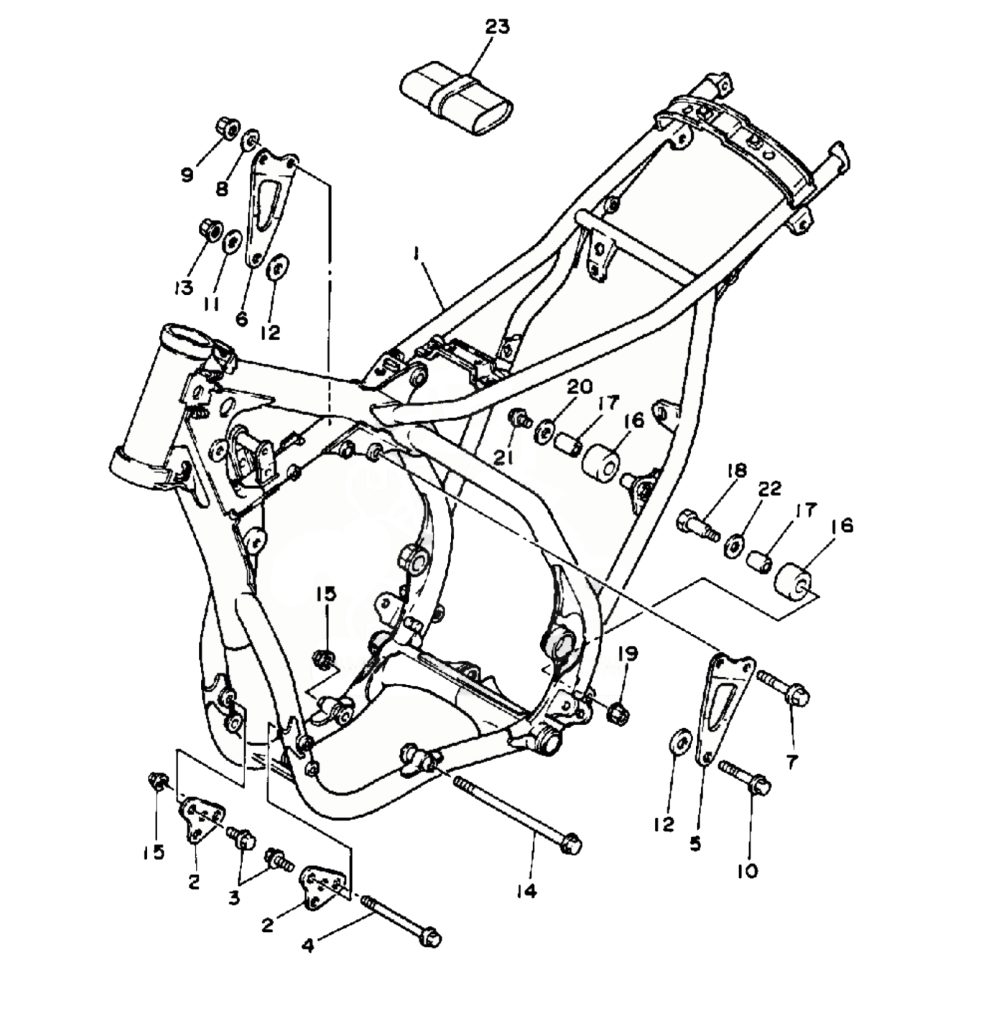 The YZ’s frame for 1986 was beefed up in several critical areas. A larger steering stem, redesigned head stay, and boxed-in swingarm pivot allowed the chassis to resist flex much better than in the past. While all of this was an improvement, the lack of a removable rear subframe did seem like an oversight in an all-new design. Photo Credit: Yamaha
The YZ’s frame for 1986 was beefed up in several critical areas. A larger steering stem, redesigned head stay, and boxed-in swingarm pivot allowed the chassis to resist flex much better than in the past. While all of this was an improvement, the lack of a removable rear subframe did seem like an oversight in an all-new design. Photo Credit: Yamaha
By 1986, nearly all the manufacturers had moved to a “Honda style” Pro-Link arrangement for their rear suspension. This meant a single large shock placed vertically and mated to a linkage mounted below the rear swingarm. Originally all of the manufacturers had tried very different approaches to rear linkage designs but by the mid-eighties nearly everyone had settled on the basic Honda design as offering the best combination of performance, packaging, and weight distribution. For 1986, Yamaha finally jumped on the Pro-Link bandwagon by introducing an all-new “bottom link” Mono Cross rear suspension on the YZ. The new design repositioned the shock to sit lower on the frame and placed it at a more vertical angle. The linkage was redesigned to sit below the swingarm, and an all-new rising rate was added to provide a more progressive action. The all-new shock retained the controversial Brake Actuated Suspension System of 1985 but relied on Yamaha’s partnership with Öhlins to provide improved damping performance. Originally envisioned as a way to improve shock compliance under breaking, the BASS used a cable-activated bypass valve to reduce compression damping when the rear brake pedal was depressed. While the system worked, it could also be inadvertently activated when hitting whoops and jumps and many riders chose to disconnect the BASS entirely.
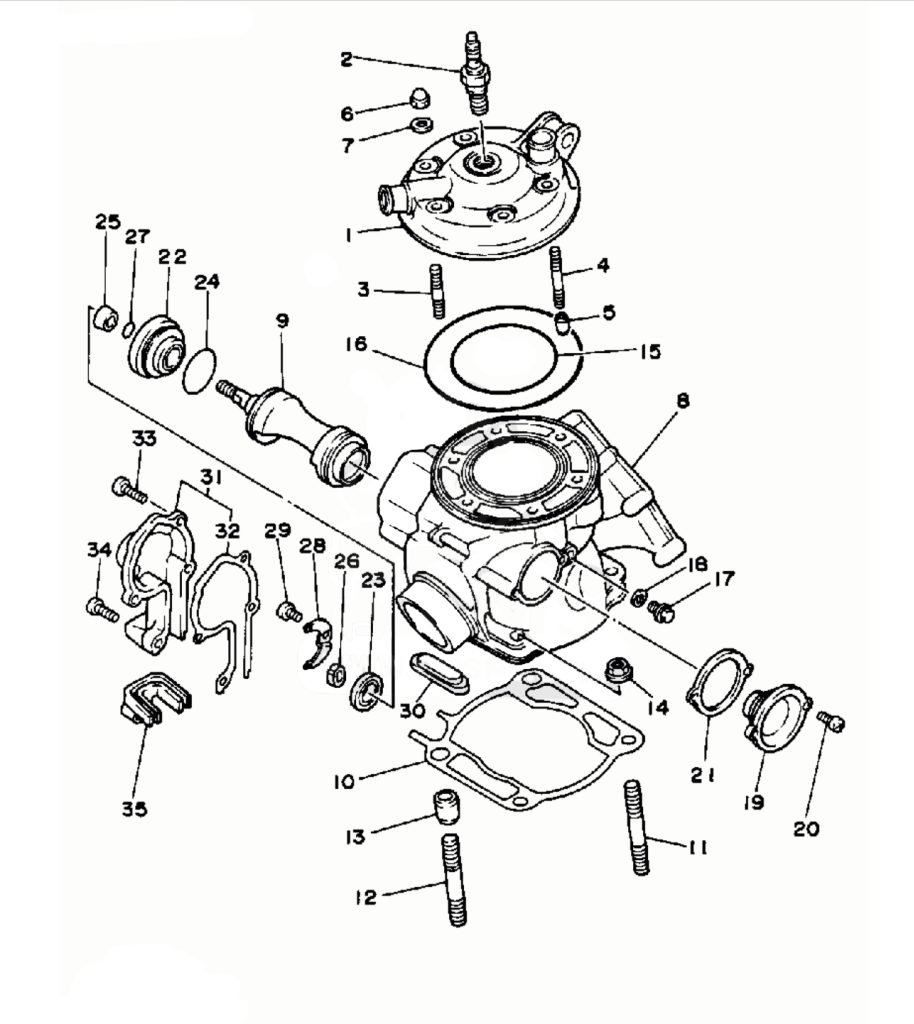 Motor changes for 1986 included an all-new new cylinder and head that replaced the old motor’s head gasket with a set of O-rings to improve heat transfer. Porting was changed as well and the YPVS drum was downsized to reduce the chance of heat warping the exhaust port. Photo Credit: Yamaha
Motor changes for 1986 included an all-new new cylinder and head that replaced the old motor’s head gasket with a set of O-rings to improve heat transfer. Porting was changed as well and the YPVS drum was downsized to reduce the chance of heat warping the exhaust port. Photo Credit: Yamaha
In addition to a revised BASS, the new shock featured an “Öhlins-style” body that integrated the remote reservoir directly into the damper. This “piggyback” arrangement saved weight, improved cooling, and reduced the chance of a hose-related shock failure. Overall travel was set at 12.6 inches and the new damper offered 28 settings for compression and 25 selectable adjustments for rebound control. Finishing off the rear suspension was a completely redesigned swingarm that featured increased bracing and a hollow pass-through to allow access to the all-new linkage.
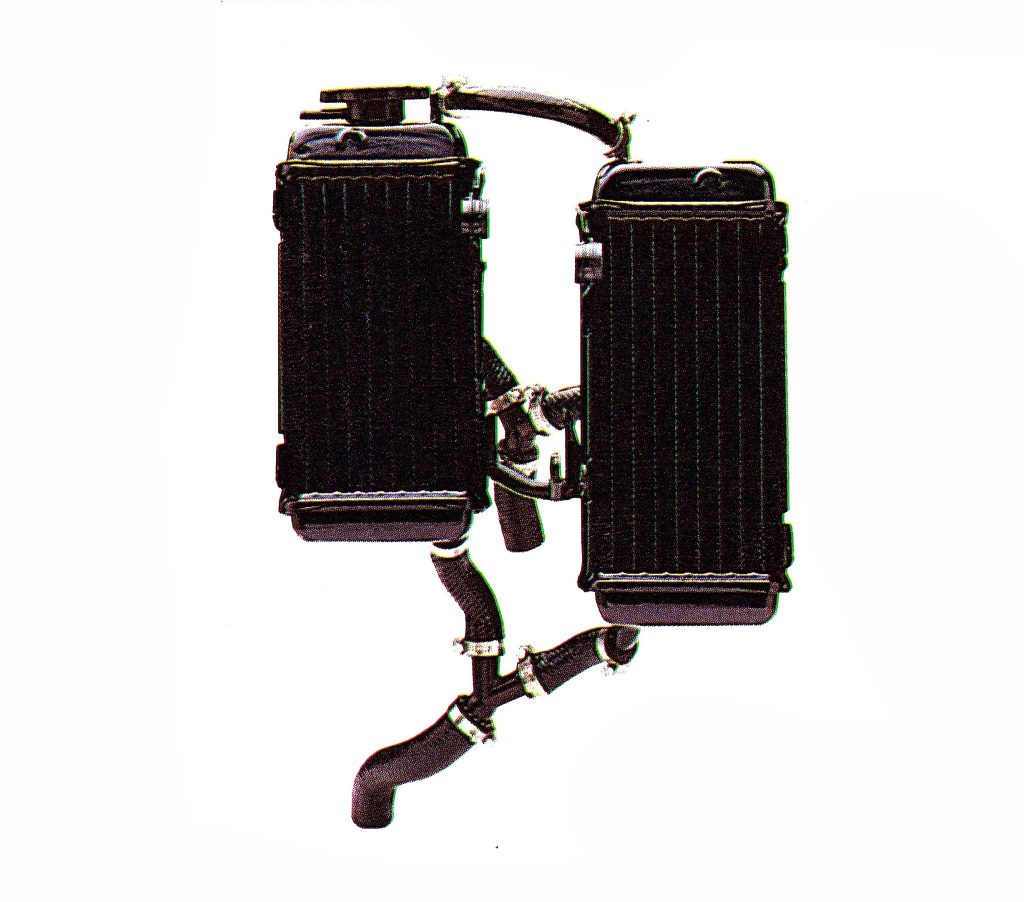 All-new radiators for 1986 sat lower on the frame and increased capacity to improve cooling. Photo Credit: Yamaha
All-new radiators for 1986 sat lower on the frame and increased capacity to improve cooling. Photo Credit: Yamaha
Up front, the 1986 YZ250 used a set of 43mm Kayaba conventional forks to provide 12 inches of travel. These forks were similar to what the YZ employed in 1985 aside from a new Alumite coating that was designed to reduce stiction and prevent premature oil contamination. The fork’s damping was a damper-rod style with air pressure and 8 selectable settings for compression damping being the only external adjustments. For 1986, Yamaha upped the spring rates slightly and massaged the damping to improve performance. Compression damping was boosted by 10 percent and rebound was increased by 15 percent. This, combined with the stiffer springs, was designed to address the utter lack of control shown by the KYB dampers in 1985.
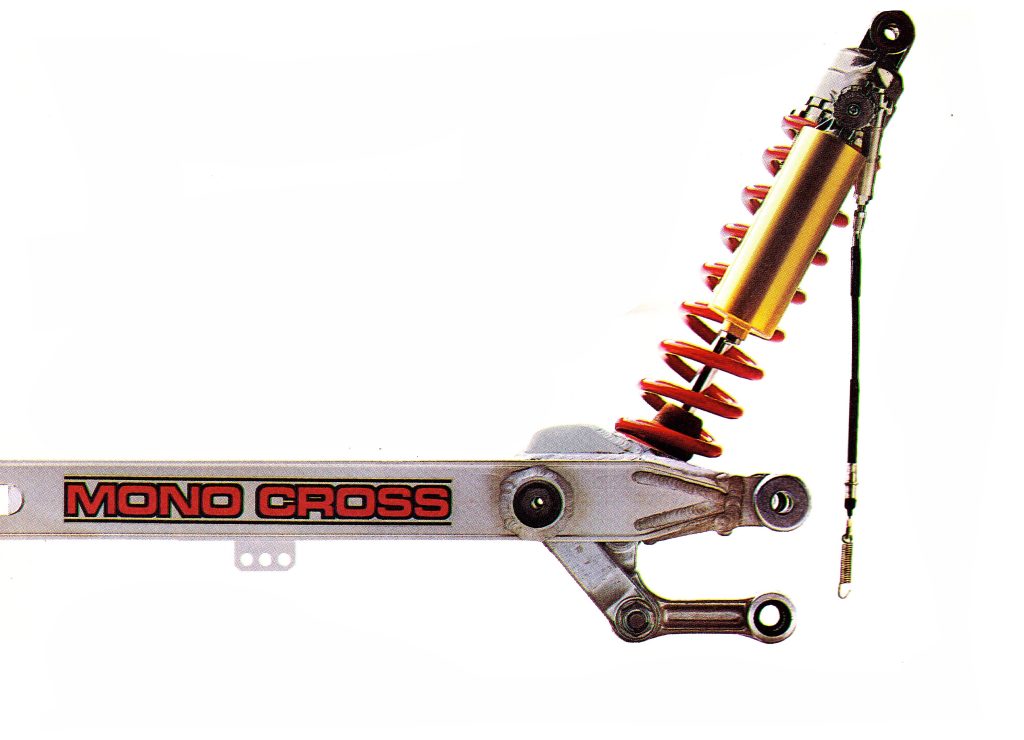 After over a decade of blazing their own trail, Yamaha finally moved to a “Honda-style” Mono Cross lower link for 1986. The new design lowered the center of gravity significantly and alleviated many of the handling quirks of previous Mono Cross systems. Photo Credit: Yamaha
After over a decade of blazing their own trail, Yamaha finally moved to a “Honda-style” Mono Cross lower link for 1986. The new design lowered the center of gravity significantly and alleviated many of the handling quirks of previous Mono Cross systems. Photo Credit: Yamaha
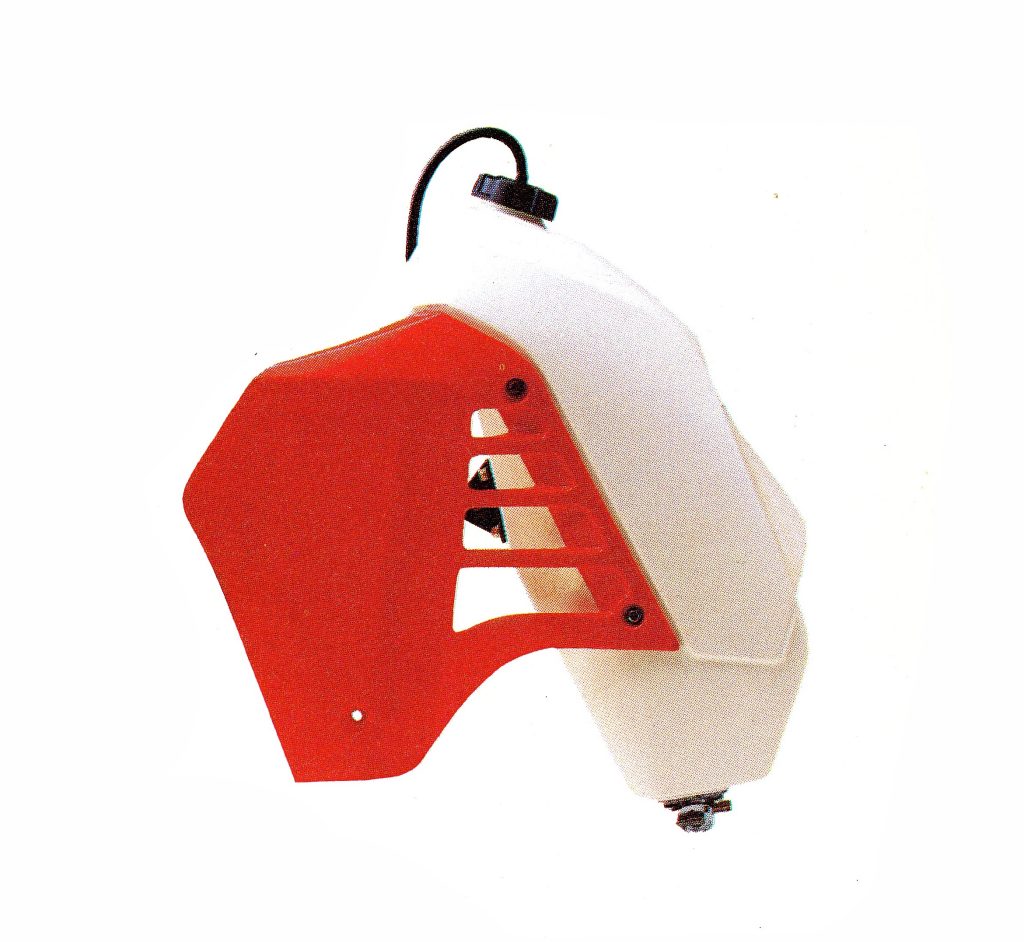 One of the biggest improvements on the YZ for 1986 was the addition of an all-new and much more streamlined tank. The new tank sat much lower and was narrower overall. This centralized mass for improved handling and made it easier for the rider to slide forward in turns. Photo Credit: Yamaha
One of the biggest improvements on the YZ for 1986 was the addition of an all-new and much more streamlined tank. The new tank sat much lower and was narrower overall. This centralized mass for improved handling and made it easier for the rider to slide forward in turns. Photo Credit: Yamaha
On the chassis front Yamaha’s goals for 1986 were improved precision through increased strength and better weight distribution. In order reduce frame flex the new steering head was increased in length by 10mm, the head stay was enlarged, and the swingarm pivot was boxed in for the first time. This increased chassis rigidity significantly and helped reduce the “loose” feeling many riders had complained of in the rough the year before. Chassis geometry was all-new as well with Yamaha focusing on providing better traction to the front wheel. All-new bodywork was added that was far slimmer through the middle and flatter across the pilot compartment. The new tank carried slightly less fuel but was far less obtrusive than in previous years. The shape was one of the narrowest in the class and the new tank lowered the bike’s mass significantly through the use of a works-style dropped section on the left. Accompanying the new tank was a redesigned set of radiators that offered more capacity for increased cooling and a lower placement for improved handling. For braking, the 1986 YZ250 employed an all-new disc system in the front and traditional drum in the rear. The new disc featured a revised disc material, smaller diameter, and new pad material. All of this was done to improve feel without sacrificing overall power and performance.
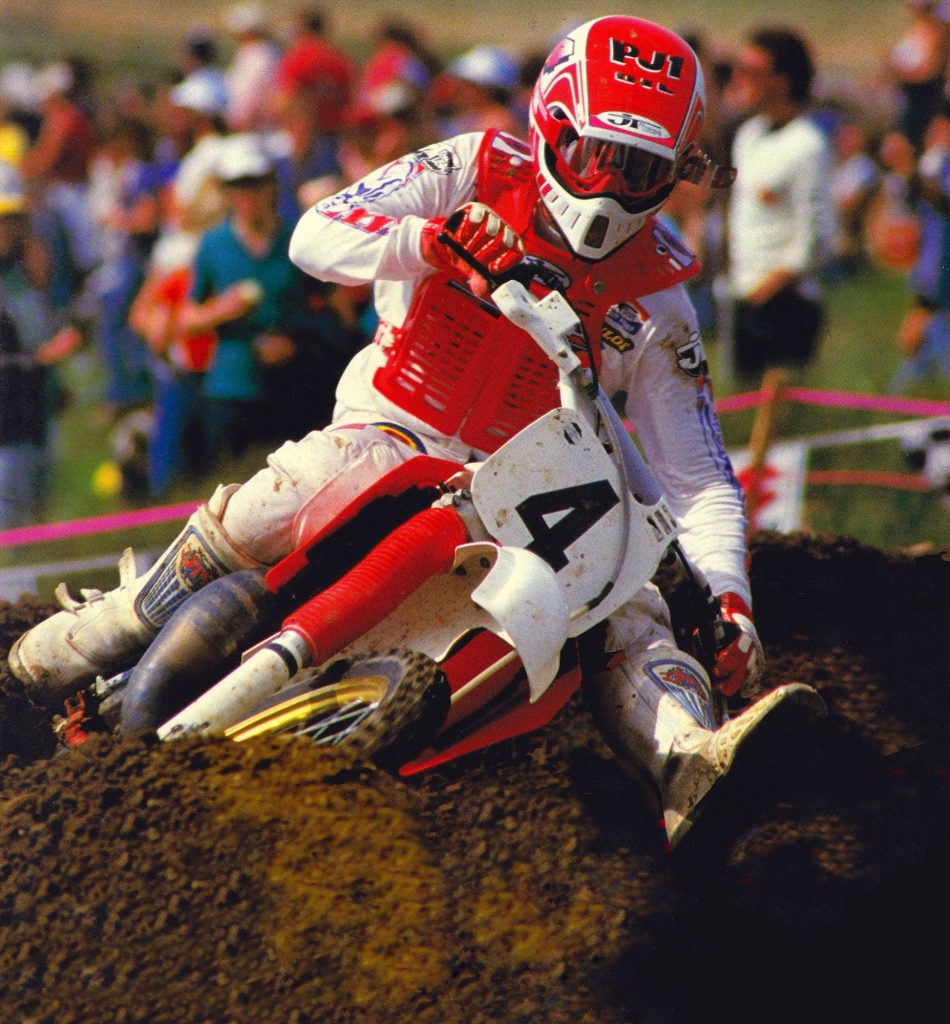 On the track the YZ exhibited much-improved handling traits in 1986. The machine’s turning response was second only to the CR and its stability at speed was second to none. Here Factory Yamaha star Broc Glover demonstrates the new machine’s willingness to carve a tight line. Photo Credit: Dirt Bike
On the track the YZ exhibited much-improved handling traits in 1986. The machine’s turning response was second only to the CR and its stability at speed was second to none. Here Factory Yamaha star Broc Glover demonstrates the new machine’s willingness to carve a tight line. Photo Credit: Dirt Bike
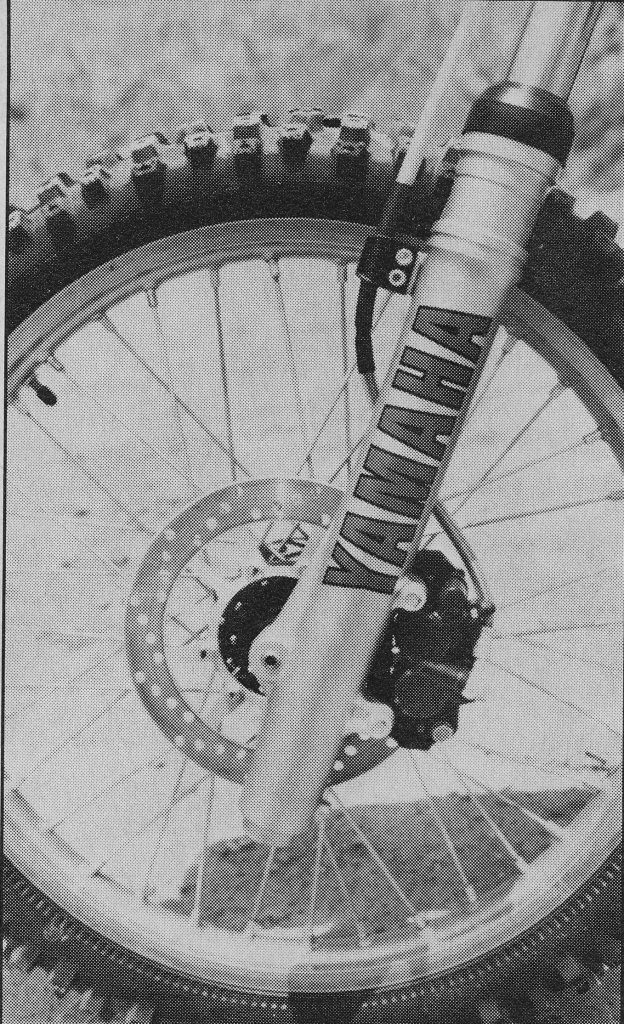 An all-new front wheel for 1986 moved away from the failure-prone “Z-spokes” of ’84 and ’85. In a rather surprising move, the front rotor was also downsized in an effort to improve braking feel. Today, this 170mm front rotor would barely be bigger than what KTM puts on its 50cc racers. Photo Credit: Motocross Action
An all-new front wheel for 1986 moved away from the failure-prone “Z-spokes” of ’84 and ’85. In a rather surprising move, the front rotor was also downsized in an effort to improve braking feel. Today, this 170mm front rotor would barely be bigger than what KTM puts on its 50cc racers. Photo Credit: Motocross Action
On the motor front Yamaha focused on refinement rather than redesign in 1986. In 1985, the YZ had enjoyed the best motor in the field and Yamaha’s goal for ‘86 was to widen the powerband and increase reliability. In order to do this Yamaha spec’d an all-new cylinder with revised porting, enlarged coolant passages, thicker castings, and a move to O-rings for the head gasket material. The YPVS drum was decreased in size and the exhaust port was reshaped to reduce the chance of heat-related deformation of the cylinder under hard use. The piston was also beefed up for 1986 in a further effort to improve durability.
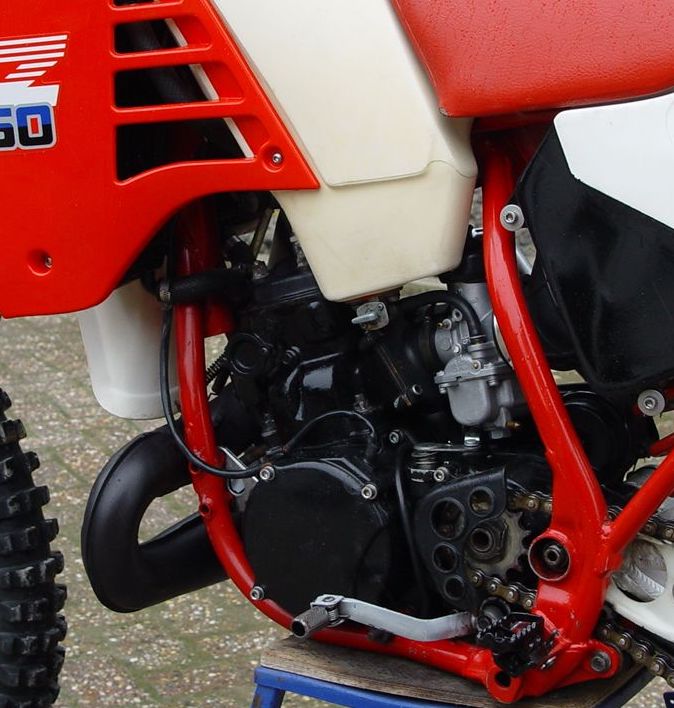 New ratios for the transmission raised third through fifth gear for 1986. Photo Credit: Unknown
New ratios for the transmission raised third through fifth gear for 1986. Photo Credit: Unknown
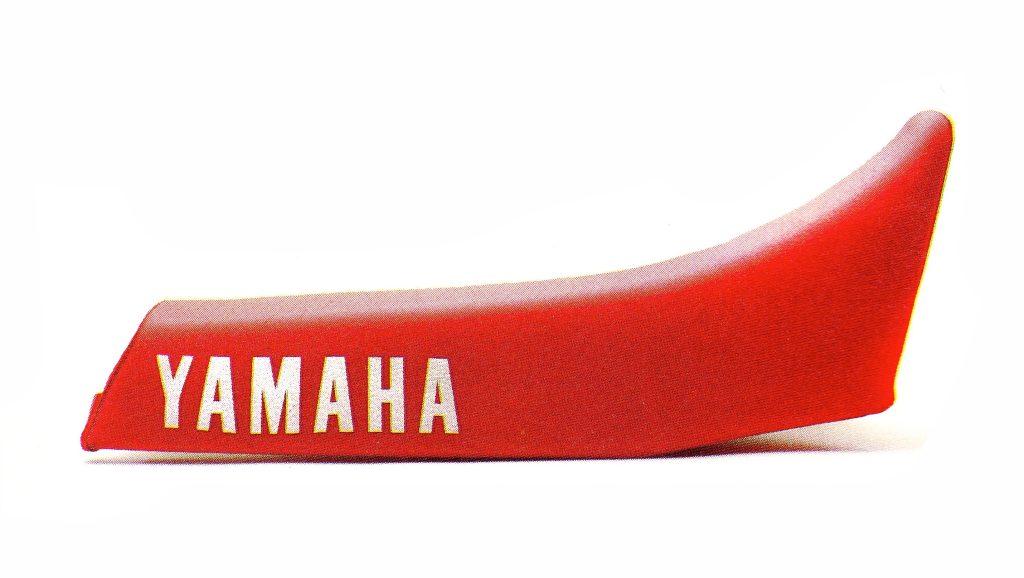 An all-new flatter seat for 1986 eliminated the dreaded “banana” shape of previous YZ saddles. Photo Credit: Yamaha
An all-new flatter seat for 1986 eliminated the dreaded “banana” shape of previous YZ saddles. Photo Credit: Yamaha
In the bottom end, the transmission was revised slightly for 1986 with third, fourth, and fifth gear offering wider spacing than the year before. In order to improve shifting feel, the YZ250 adopted the YZ490’s longer shift lever for 1986. This provided greater leverage but did not entirely address the Yamaha’s notoriously notchy shifting. An all-new airbox for 1986 offered slightly more volume but the YZ250 did not receive the YZ125’s trick new Mikuni “flat-slide” TM carburetor. Instead, the 250 made do with an older 38mm VM “round slide” Mikuni mixer. Finishing off the motor package was an all-new exhaust system that was said to boost top-end power by mimicking the dimensions of Rick Johnson’s 1985 works exhaust.
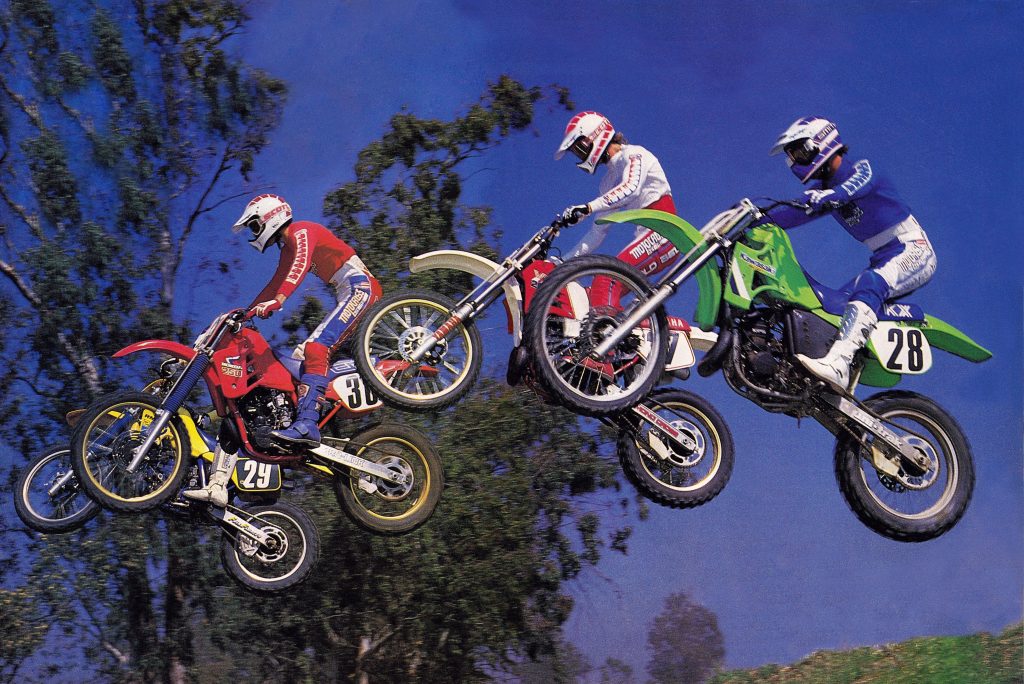 In 1986, all the machines were playing second fiddle to Honda’s omnipotent CR250R. Photo Credit: Motocross Action.
In 1986, all the machines were playing second fiddle to Honda’s omnipotent CR250R. Photo Credit: Motocross Action.
 The YZ’s new Kayaba forks for 1986 lacked the CR’s more sophisticated cartridge internals but did feature improved action and durability through the use of a slick Alumite coating that reduced friction. Photo Credit: Yamaha
The YZ’s new Kayaba forks for 1986 lacked the CR’s more sophisticated cartridge internals but did feature improved action and durability through the use of a slick Alumite coating that reduced friction. Photo Credit: Yamaha
On the track the YZ was significantly improved in some areas and less successful in others. The new ergonomics were loved by all and the YZ offered the slimmest riding compartment in the class. The new seat and tank made it easier to get forward in turns and the bike felt lighter than its 229 pounds would indicate. The new bike was far more accurate in the turns while also offering admirable stability at speed. It was not as Ginsu-like in the turns as the Honda, but neither were any of the CR’s competitors in 1986. Even the annoying Yama-hop of previous YZs seemed to be mostly exorcised by the new more robust chassis and redesigned rear suspension. Overall, it was a solid handling package and a major improvement over previous Yamaha efforts.
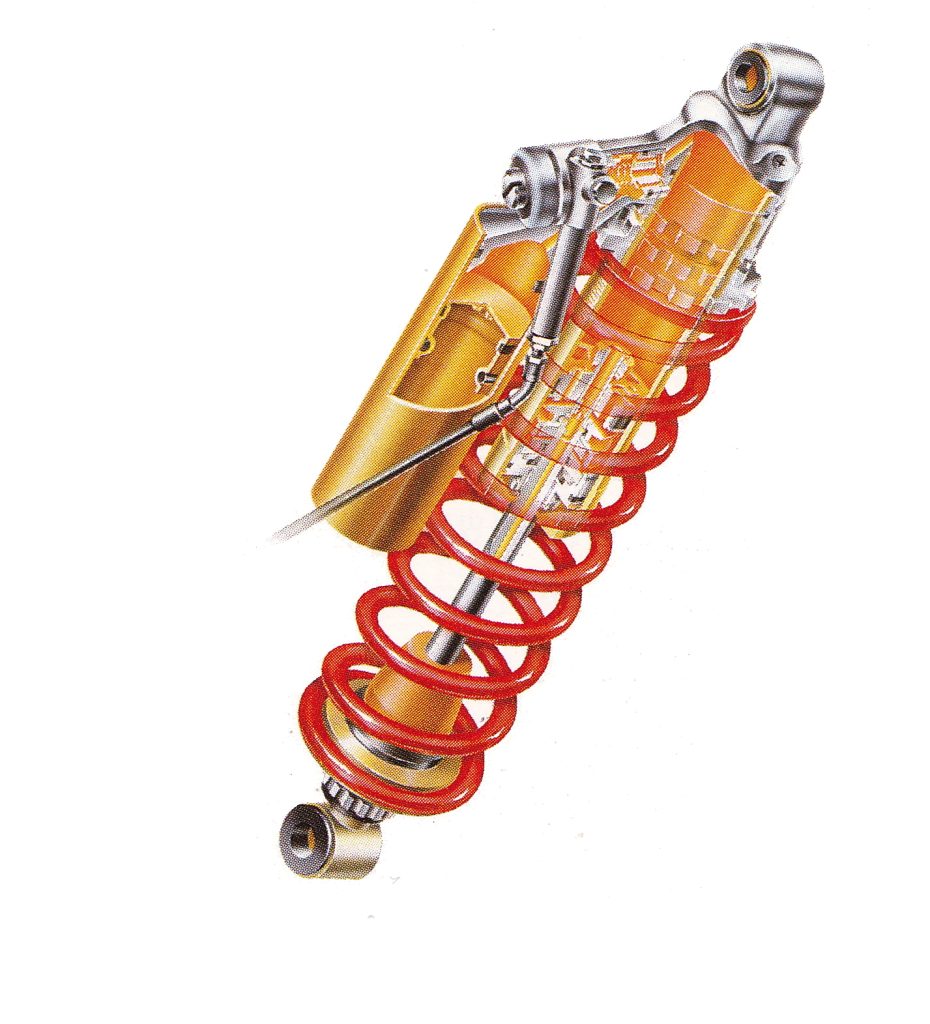 An all-new Öhlins-designed shock for 1986 moved the reservoir to the shock body and featured all-new valving and an increase in spring rate for better fade resistance and increased control. Photo Credit: Yamaha
An all-new Öhlins-designed shock for 1986 moved the reservoir to the shock body and featured all-new valving and an increase in spring rate for better fade resistance and increased control. Photo Credit: Yamaha
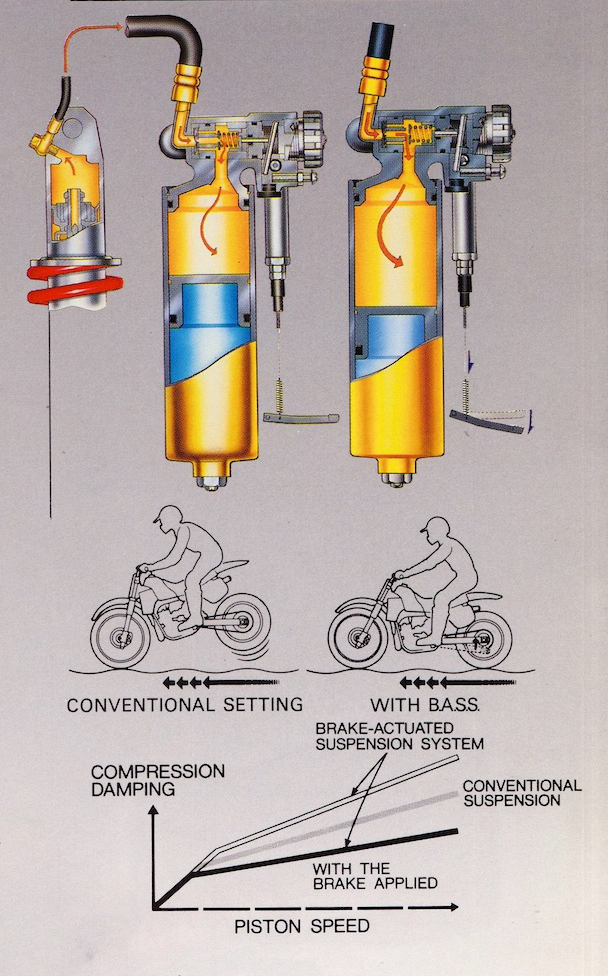 For 1986, Yamaha’s new rear suspension retained the Brake-Actuated Suspension System (BASS) it had introduced in 1985. Designed to improve suspension compliance under braking by reducing the compression damping once the rear brake was applied, the BASS proved controversial with riders. While some praised its effectiveness, many found it either intrusive or ineffectual and disconnected it altogether. Photo Credit: Yamaha
For 1986, Yamaha’s new rear suspension retained the Brake-Actuated Suspension System (BASS) it had introduced in 1985. Designed to improve suspension compliance under braking by reducing the compression damping once the rear brake was applied, the BASS proved controversial with riders. While some praised its effectiveness, many found it either intrusive or ineffectual and disconnected it altogether. Photo Credit: Yamaha
On the handling front, the only real complaints in 1986 were tied to the YZ’s rather pedestrian suspension performance. Without the sophistication of the Honda’s cartridge damping system the Yamaha’s forks offered a less-responsive feel to small chop and were generally far less plush overall. Large jumps and big whoops were no issue, but the forks deflected rather than absorbing the braking bumps and small holes that litter most hard-pack tracks. While the new hard-coated forks were a huge improvement over the marshmallow-like 1985 units, their slightly harsh action paled in comparison to the magic carpet ride delivered by the CR in 1986.
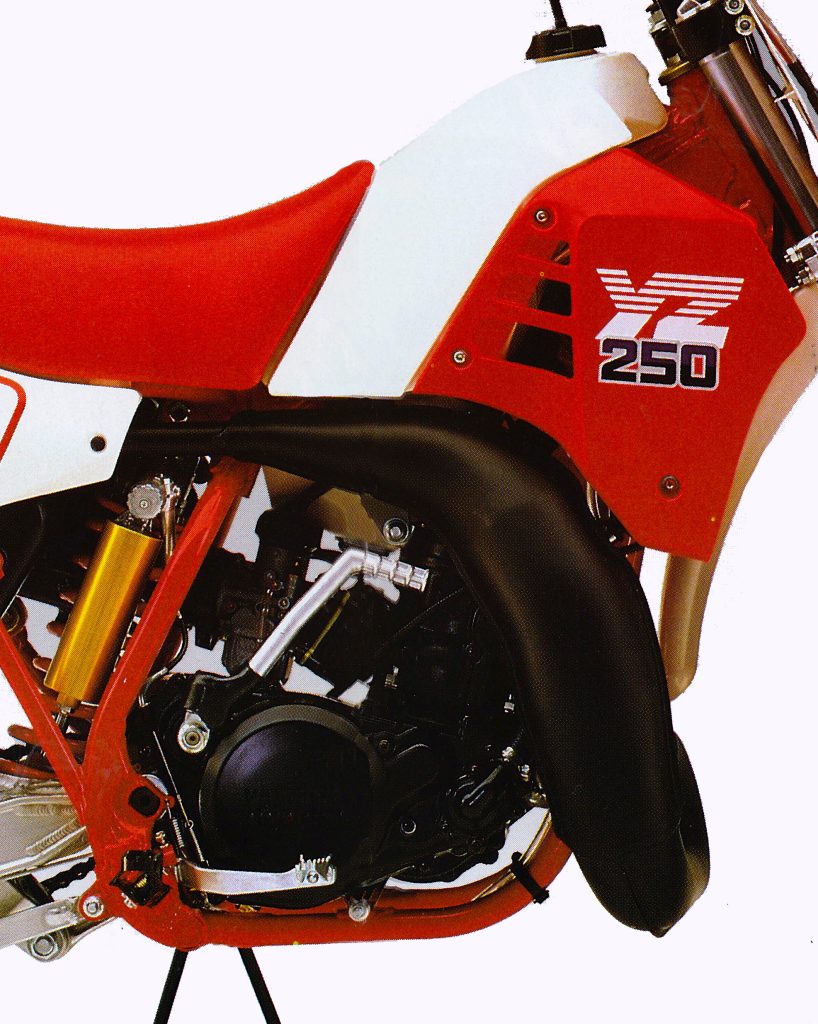 The motor changes for 1986 yielded controversial results. The ’85 mill’s awesome torque and midrange blast were smoothed out and moved up higher into the power curve. The new motor pulled much farther on top but lacked the instant burst of 1985. While this pleased some pros, most riders preferred the easier to use power of the old motor. Photo Credit: Yamaha
The motor changes for 1986 yielded controversial results. The ’85 mill’s awesome torque and midrange blast were smoothed out and moved up higher into the power curve. The new motor pulled much farther on top but lacked the instant burst of 1985. While this pleased some pros, most riders preferred the easier to use power of the old motor. Photo Credit: Yamaha
Out back, it was a similar story as the Öhlins designed shock and new Mono Cross delivered a firm ride that laughed at big hits but was flummoxed by smaller impacts. Acceleration bumps out of turns were transmitted directly to the rider’s backside and riders were generally split on whether the BASS improved this feeling under braking. Some riders claimed the BASS made a noticeable difference while coming down from speed while others could not feel any real improvement in the shock’s compliance over braking bumps. In both cases, the shock’s action was only rated as acceptable in these conditions. Compared to 1985, the new rear end was a huge improvement and most riders felt they could live with a slight bit of harshness as a tradeoff for the new rear end’s much better control at speed. There was none of the old machine’s bottoming, wallowing, and sudden kicking and the YZ could be trusted to not do anything unexpected in the rough.
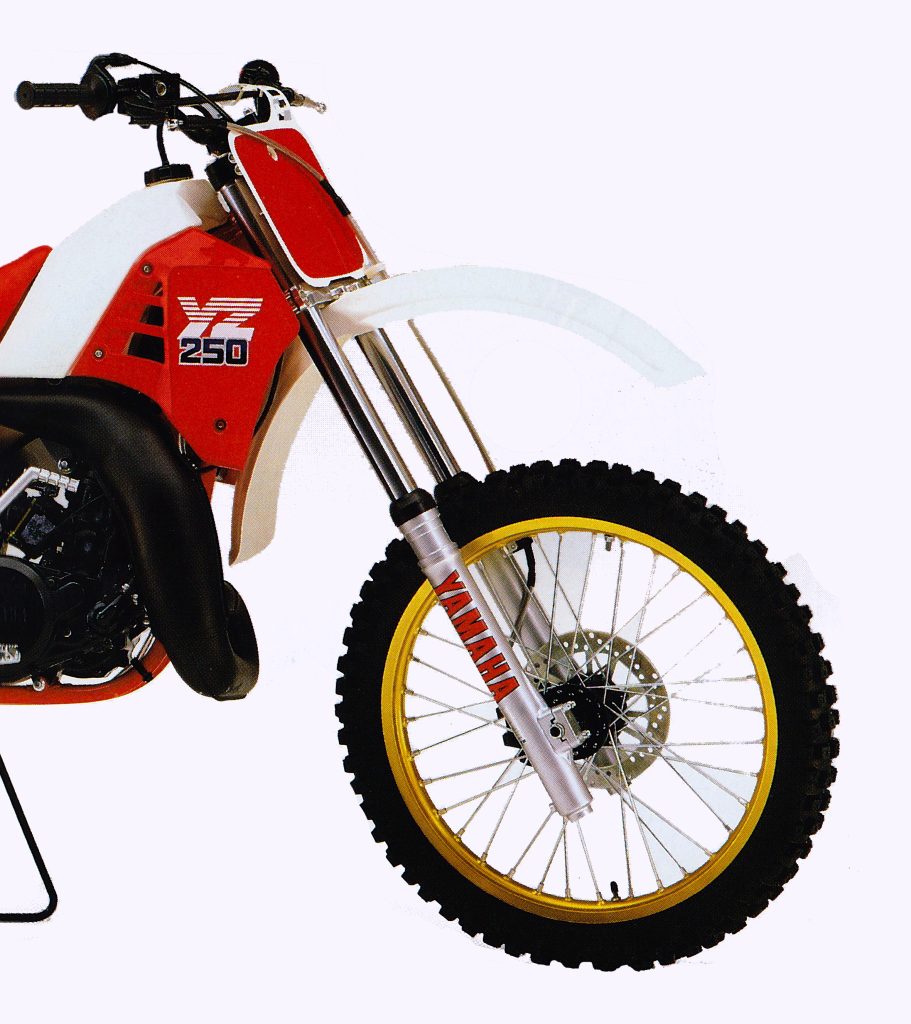
Stiffer springs and firmer valving gave the 43mm KYB forks on the YZ much better performance than in 1985. The new forks worked well on Supercross-style obstacles but lacked the plushness and control of Honda’s revolutionary new Showa cartridge components. Photo Credit: Yamaha
Of all the changes made to the YZ250 in 1986, by far the most controversial was its all-new power profile. In 1985, the YZ had been a low-to-mid monster with gobs of torque and instantaneous throttle response. It was by far the fastest motor and quick enough to win national-level races in nearly stock condition. In 1985, the only real complaints leveled at the YZ’s motor were its notchy shifting and relative lack of top-end power. Thankfully, its torquey motor did not require a ton of shifting but really fast guys still wanted a few more revs.
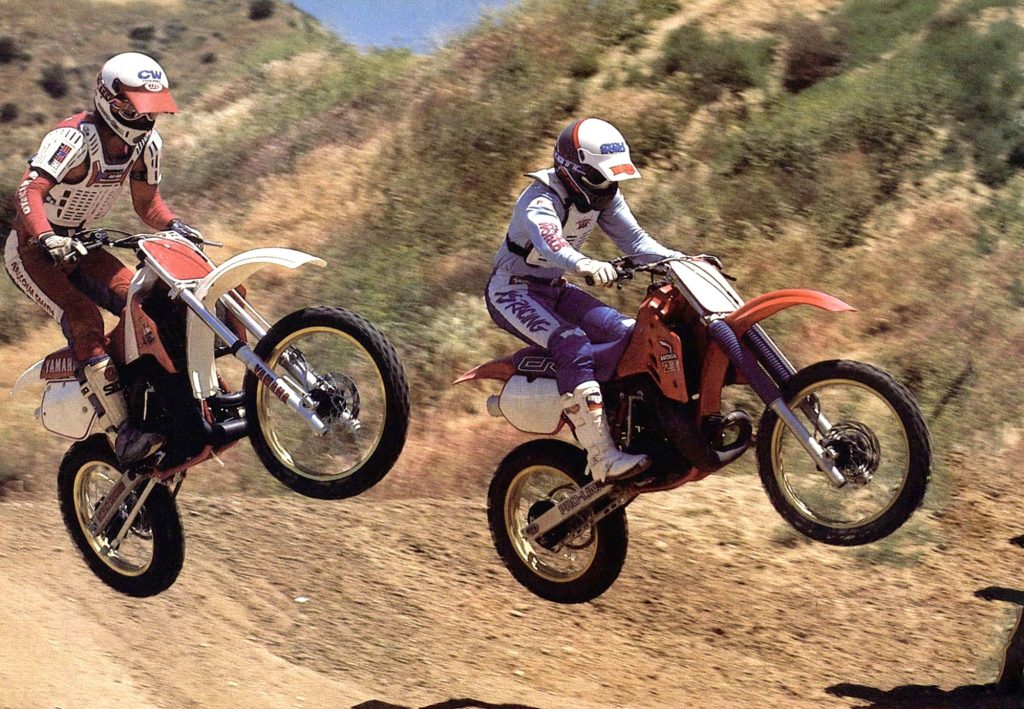 In 1986, the Honda CR250R was head and shoulders ahead of its rivals but the Yamaha was a capable competitor in the right hands. The CR offered supple suspension and an incredibly broad motor the YZ could not match, but the Yamaha’s handling and strong top-end performance made it competitive if the rider was fast enough to make its stiff suspension and pro-oriented powerband work. Photo Credit: Cycle World.
In 1986, the Honda CR250R was head and shoulders ahead of its rivals but the Yamaha was a capable competitor in the right hands. The CR offered supple suspension and an incredibly broad motor the YZ could not match, but the Yamaha’s handling and strong top-end performance made it competitive if the rider was fast enough to make its stiff suspension and pro-oriented powerband work. Photo Credit: Cycle World.
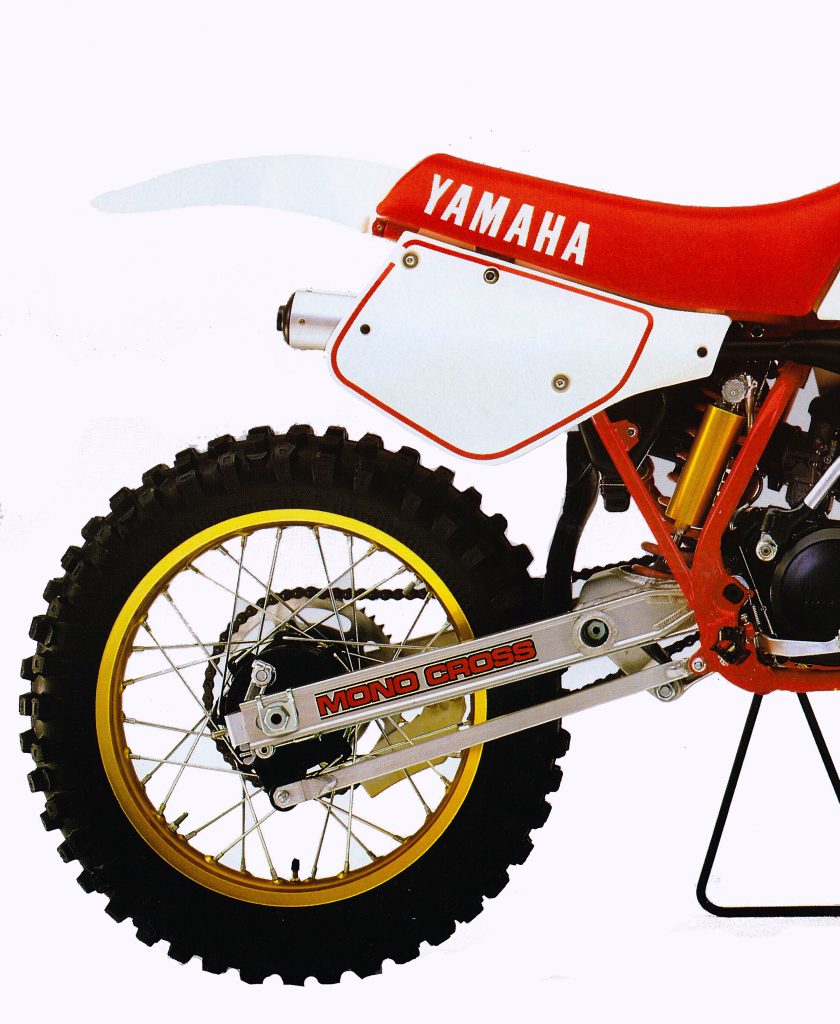 The new Mono Cross rear suspension on the ’86 YZ lacked plushness but offered much better control than past Yamaha efforts. There was none of the unexpected kicking riders had come to fear from their YZs and it took big hits and large whoops in stride. Only its lack of plushness held it back from being the best rear suspension of 1986. Photo Credit: Yamaha
The new Mono Cross rear suspension on the ’86 YZ lacked plushness but offered much better control than past Yamaha efforts. There was none of the unexpected kicking riders had come to fear from their YZs and it took big hits and large whoops in stride. Only its lack of plushness held it back from being the best rear suspension of 1986. Photo Credit: Yamaha
For 1986, Yamaha went searching for those missing RPMs and found them in spades. Unlike the tractor-like ’85 mill, the new ’86 version came on soft down low before catching fire in the midrange. Top end power was much improved and the YZ pulled the farthest of any machine in the ’86 250 field. Once on the pipe, it was blazing fast, but the new powerband was far harder to use than in the past. Making the most of its high-RPM rush required skill and commitment and this new “go-for-broke” approach only exacerbated the YZ’s notoriously recalcitrant shifting. Shifting under power required the use of the clutch and it was all but impossible to catch the next gear without backing off the throttle slightly. Even worse, if you did miss a shift, you no longer had the old motor’s mountain of torque to fall back on. Flubbing a shift meant losing a great deal of time as you flogged the clutch in an attempt to get the YZ back in the meat of its power. Pro riders had an easier time dealing with the YZ’s new power characteristics but even most of them preferred the old motor to the new one.
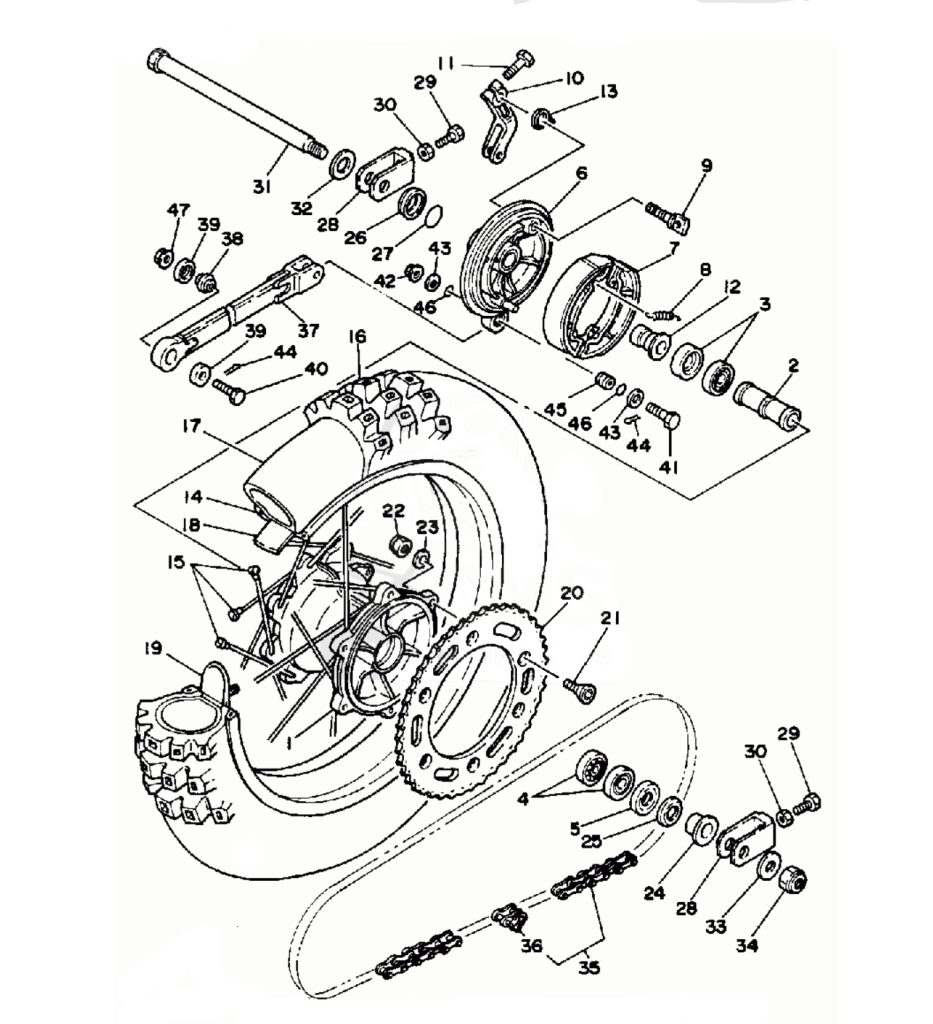 The rear wheel of the ‘86 YZ250 kept the Z-spokes and drum brake of 1985 and offered mediocre braking performance. Photo Credit: Yamaha
The rear wheel of the ‘86 YZ250 kept the Z-spokes and drum brake of 1985 and offered mediocre braking performance. Photo Credit: Yamaha
On the detailing front the YZ was a solid machine overall. Everyone loved the new bodywork and slim layout, but the new drop tank did make servicing the carburetor slightly more challenging. The new frame was more robust, but some cracks were reported in the area where the backbone met the shock mount. The triple clamps were also prone to cracking if the pinch bolts were cinched down too tightly. The lack of a removable subframe also seemed like a large oversight on an all-new design. This made accessing the shock an unnecessary hassle compared to the CR and KX. The new front wheel ditched the problematic “Z-spokes” of ’84-’85 and replaced them with traditional straight-pull spokes. This eliminated one of the major failure points on the on the old machine, but the rear wheel maintained the Z-spoke arrangement, so care had to be taken not to let the spokes get loose and crack the hub. While drum rear brakes were still de rigueur in 1986, the YZ’s rear binder was poor even by those standards. It offered a mushy pedal feel and lackluster power. At least the front binder was improved in spite of its smaller size. Most riders liked its progressive feel, but fast guys preferred the ultra-powerful brakes found on the Honda and Kawasaki.
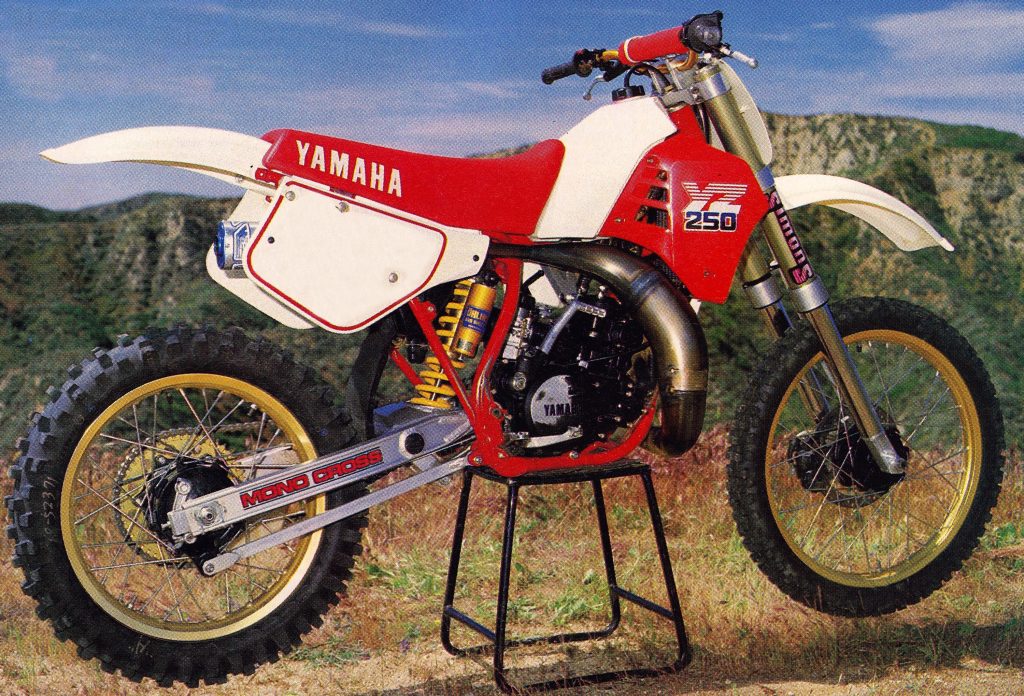 With a new exhaust system and some suspension upgrades Dirt Bike’s ’86 project bike proved that the new YZ250 was more than capable of running with any machine in motocross. Photo Credit: Dirt Bike
With a new exhaust system and some suspension upgrades Dirt Bike’s ’86 project bike proved that the new YZ250 was more than capable of running with any machine in motocross. Photo Credit: Dirt Bike
Overall motor reliability was excellent, but it was important to make sure the YPVS was adjusted correctly. Some riders also found the new high-RPM powerband easier to live with by adding an additional tooth or two to the rear sprocket. This helped punch up the low end and got the bike into the meat of the powerband more quickly. This also helped take some stress off the YZ’s clutch, which was not up to a lot of abuse. While the new forks were mediocre performers, the new Alumite coating helped keep the fluid cleaner and prolonged servicing intervals considerably. The new slick coating also seemed to improve seal life in spite of the lack of fork boots for 1986.
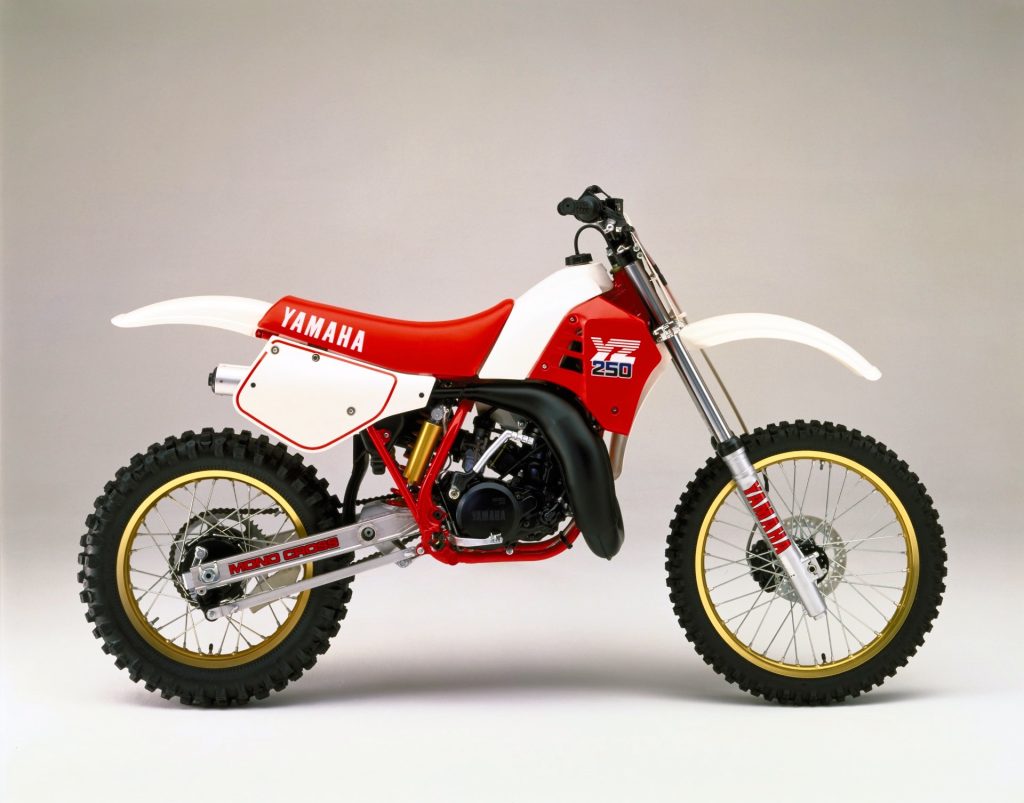 Slim, sleek, and sexy to behold, Yamaha’s 1986 YZ250 was a very different machine than its predecessors. Firmly suspended and high-strung, it offered improved handling in a package that required skill to make the most of its potential. Photo Credit: Yamaha
Slim, sleek, and sexy to behold, Yamaha’s 1986 YZ250 was a very different machine than its predecessors. Firmly suspended and high-strung, it offered improved handling in a package that required skill to make the most of its potential. Photo Credit: Yamaha
Overall, the 1986 Yamaha YZ250 proved to be a significant improvement in some areas and a bit of a setback in others. The handling, ergonomics, and suspension of the machine were all greatly improved, but the motor was no longer King of the class. It was still plenty fast but making the most of that speed demanded talent. The stiff suspension and high-RPM power made the YZ more pro focused and put off many of lesser speed and skill. With some suspension tuning and a little motor massaging the 1986 YZ250 made a very competitive mount, but in stock condition it had to play second fiddle to Honda’s silky smooth CR250R.





